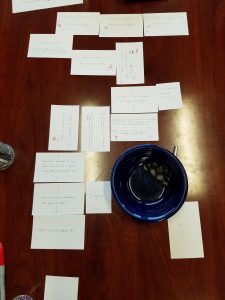Home Front: Week Sixteen
Like any good piece of media these days, it seems only appropriate to have a post-credits scene before we truly put the project to bed. Week Sixteen was one of endings.
On Monday, we presented on our process and product for faculty and the collected student body of the ETC. Summarizing fifteen weeks into fifteen minutes was not the easiest task, but the team made it through clearly, succinctly, and with aplomb.
A majority of the week was spent readying our documentation for Theater of War Productions. In addition to formal documentation, such as design explanation of rules and source code, the team also included our personal observations on the difficulties and benefits we found in translating our client’s existing model in to the tabletop space. The goal behind all of the documentation was that if our client wanted to hand off future design to another group, there would be enough information to enable a smooth transition.
We ended the week, and the project, with Final Playthroughs. Final Playthroughs act as one last chance for the faculty to see our deliverable in action before finalizing our product grade. They finished at noon, and our work was complete.
Thank you for being here for our journey. It was an incredibly experience for the team, and I hope you found something in these blog posts that you can take away as well.

